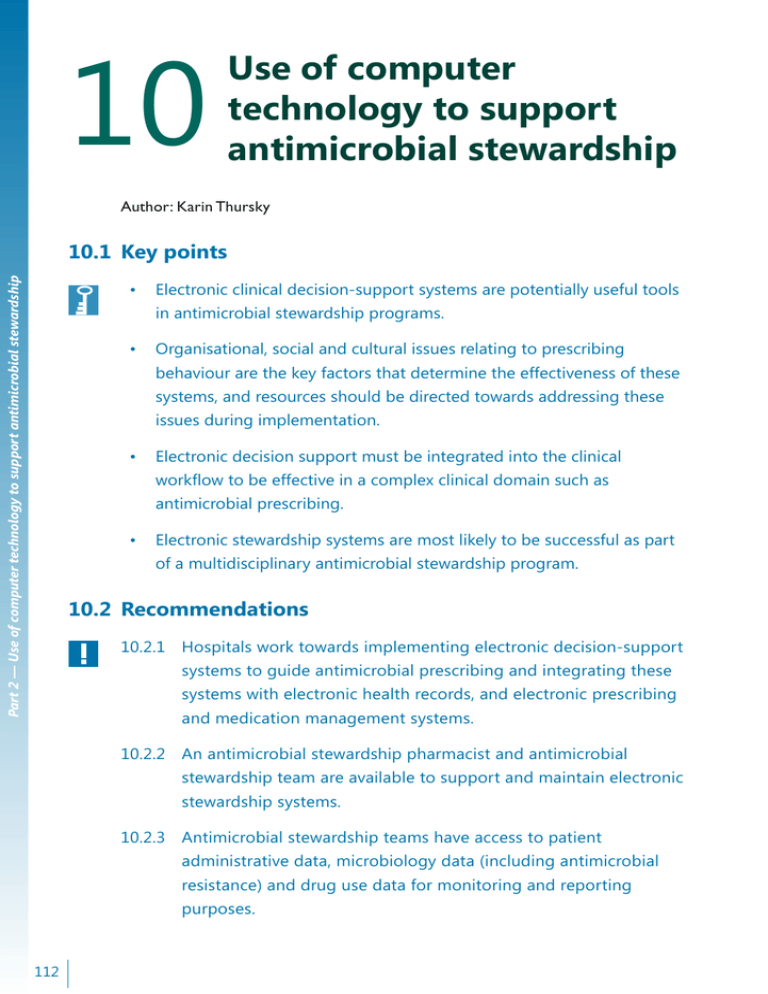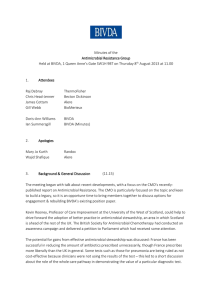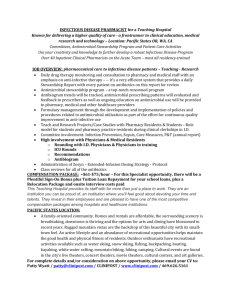10Use of computer technology to support antimicrobial stewardship
advertisement

10 Use of computer technology to support antimicrobial stewardship Author: Karin Thursky Part 2 — Use of computer technology to support antimicrobial stewardship 10.1 Key points • Electronic clinical decision-support systems are potentially useful tools in antimicrobial stewardship programs. • Organisational, social and cultural issues relating to prescribing behaviour are the key factors that determine the effectiveness of these systems, and resources should be directed towards addressing these issues during implementation. • Electronic decision support must be integrated into the clinical workflow to be effective in a complex clinical domain such as antimicrobial prescribing. • Electronic stewardship systems are most likely to be successful as part of a multidisciplinary antimicrobial stewardship program. 10.2 Recommendations 10.2.1 Hospitals work towards implementing electronic decision-support systems to guide antimicrobial prescribing and integrating these systems with electronic health records, and electronic prescribing and medication management systems. 10.2.2 An antimicrobial stewardship pharmacist and antimicrobial stewardship team are available to support and maintain electronic stewardship systems. 10.2.3 Antimicrobial stewardship teams have access to patient administrative data, microbiology data (including antimicrobial resistance) and drug use data for monitoring and reporting purposes. 112 10.3 Use of computer technology to support antimicrobial stewardship The years 2010–20 will see the development of electronic medical records, electronic prescribing and computerised clinical decision support in hospitals. There is a move towards electronic medication management in the acute healthcare setting in Australia, with both state and federal government-sponsored initiatives to modernise the healthcare information technology infrastructure.a This will provide opportunities to integrate antimicrobial stewardship (AMS) activities with electronic prescribing and medication management systems. Electronic clinical decision-support systems (CDSS) appear to improve the quality of prescribing and reduce the costs of antimicrobial prescribing, but their overall cost-effectiveness, and impact on patient outcome and antimicrobial resistance is much less certain. There have been two published reviews on CDSS and its use in antimicrobial prescribing.138-139 Current opinion from key infectious diseases bodies supports the use of CDSS as potentially useful tools in AMS programs, and the use of electronic antimicrobial approval systems has been recommended by both the Victorian and New South Wales health departments.140, b 10.4 Electronic antimicrobial decision-support systems Electronic CDSS can be as simple as online access to formulary restrictions, local antimicrobial prescribing guidelines and Therapeutic Guidelines: Antibiotic19 via the hospital intranet. More complex systems can include integrated CDSS embedded within other applications, such as pharmacy dispensing systems or electronic prescribing systems. 10.4.1 Use and benefits of electronic decision support in antimicrobial stewardship There have been several systematic reviews evaluating the effectiveness of CDSS and e-prescribing systems.141-144 CDSS appears to be effective in reducing medication error, and increasing physician guideline uptake and concordance.141-144 The most effective CDSS were those that were coupled to an electronic medical record or e-prescribing system. However, there are very few published examples of antimicrobial CDSS embedded in electronic prescribing systems and these are confined to two major institutions in the United States.52, 63 The Antibiotic Assistant program at the Latter Day Saints Hospital, Utah,52 is an advanced CDSS able to generate patient and situation-specific antimicrobial treatment recommendations based on data from the individual electronic health record. The results of the antimicrobial management program were reported in 199852 and the study is widely cited in the literature as the benchmark for CDSS in antimicrobial control.145 The before-and-after study was performed in the 12-bed a www.health.gov.au/internet/main/publishing.nsf/Content/National+Ehealth+Strategy b www.health.nsw.gov.au/resources/quality/hai/pdf/mros_keyrecommendations.pdf 113 Part 2 — Use of computer technology to support antimicrobial stewardship intensive care unit in 1992–95. There was a significant reduction in antimicrobial mismatches, drug alerts, adverse drug events (ADEs) and hospitalisation costs in those patients in whom the program was followed. This was in comparison with the historical cohort or in the patients in whom the program was overridden. Interestingly, only 46% of antimicrobial selection recommendations were followed, compared with 94% of antimicrobial dosing suggestions. Four years after this study was reported, a prospective study was performed to evaluate the concordance between physician’s orders and the recommendations made by the program. Of the 1078 physicians’ and Antibiotic Assistant order days, there was only 33% concordance. The authors attribute this fall in concordance to insufficient monitoring of clinician satisfaction or acceptance of information (or both), as well as insufficient education.146 Other antimicrobial decision-support systems can be classified as task-specific, such as those providing microbiology result-independent prescribing and those that provide microbiology result-guided prescribing.138-139 They may be asynchronous (i.e. they do not provide decision support at the time of prescribing). These are specialised knowledge-based expert systems that issue clinical alerts that are communicated to the clinicians after the antimicrobial is ordered. These systems include pharmacy-based antimicrobial CDSS that monitor antimicrobial prescriptions in relation to microbiology reports and generate reports of potential therapeutic mismatch.147-152 In all of these studies, full-time, dedicated, trained pharmacists were responsible for reporting the results to the treating clinicians. The majority of these systems reported reductions in antimicrobial expenditure and the use of targeted antimicrobials. Benefits that can be achieved through effective communication between these systems are similar to those demonstrated with e-prescribing systems and include: • appropriate antimicrobial choice (based on microbiology results) • optimal antimicrobial dosing and monitoring (based on pathology results) • improved clinician response time • broader use in quality improvement activities (antimicrobial resistance and simultaneous microbiology surveillance).153 Even now, few hospitals have links between pharmacy and laboratory databases, because these systems are usually incompatible commercial systems. However, improved communication between the pharmacy and the laboratory can be achieved without specialised software.154 An Australian study in an intensive care unit demonstrated that significant changes can be achieved in antimicrobial utilisation with improved display of microbiology results and point-of-care recommendations for positive isolates.155 As more advanced hospital systems are introduced, these barriers will be fewer, although significant challenges remain in ensuring that clinical decision support is appropriate and integrated into workflow for AMS. In Australia, improvements in prescribing practices have been demonstrated with the IDEA3s electronic antimicrobial advice and approval system,65 and Guidance 114 Antimicrobial stewardship in Australian hospitals DS, a transferable web-based AMS program developed by the Royal Melbourne Hospital.66 Over the three years since deployment of Guidance DS, longitudinal time series analyses of antimicrobial use and the hospital antibiogram demonstrated significant improvements in the use of broad-spectrum antimicrobials and an associated reduction of resistance in some gram-negative bacteria.66 The use of these products in AMS is described in Chapter 2. 10.4.2 Other uses of clinical decision-support systems in antimicrobial stewardship There are several examples where CDSS have been developed to assist with the identification of patients at high risk for nosocomial infection using data from the electronic patient record, and microbiology, pathology and radiology results.156-159 These systems can be used in early infection prevention programs and for surveillance activities. 10.5 Electronic prescribing and medication management systems Electronic prescribing (e-prescribing) systems are computer applications that allow clinicians to generate paper or electronic medication prescriptions. Electronic medication management systems (eMMS) are information systems that manage each phase of the medication management process: • decision support • computerised physician order entry (e-prescribing) • medication review • dispensing • recording medicines administration. Although electronic systems for ordering medicines are well established in general practice, only a small number of sites in Australia have implemented inpatient e-prescribing. However, commercial e-prescribing and eMMS systems will be implemented across many institutions within the next 5–10 years. These commercial solutions will require substantial organisational changes and incur significant costs. The high cost of implementing e-prescribing systems, and the challenges of integrating into existing information systems and convincing physicians to use these programs, largely explains the low prevalence of these systems in both American and Australian hospitals.1 According to the Leapfrog Group,a the costs of implementing e-prescribing systems will far exceed potential savings from drug-cost avoidance and ADE avoidance in most hospitals.160 In Australia, the majority of hospitals lack the foundations required for successful implementation of eMMS. Many are in a state of transition between paper-based medical records and electronic medical records. a The Leapfrog Group supports improvements in the safety, quality and affordability of health care. It is an initiative of purchasers of health care in the United States: www.leapfroggroup.org. Use of computer technology to support antimicrobial stewardship 115 Currently available commercial e-prescribing software systems have limited decision-support capability that is largely limited to rule-based decision support. The majority of antimicrobial decision support in commercial hospital eMMS is limited to commercial drug-interaction packages or drug-information databases. Almost all commercial systems are associated with front-end decision support provided at the time of prescribing such as default values, routes of administration, dose and frequencies. They may also include drug-allergy checks, drug interaction and drug-laboratory value checks. However, the use of front-end alerts can cause frustration for clinicians if numerous warnings pop up during order entry161 and they may start overriding such alerts. Part 2 — Use of computer technology to support antimicrobial stewardship The safety of commercial e-prescribing systems providing decision support is largely unknown, and there are emerging reports of systematic medication errors occurring with some systems if not safely implemented.162-163 Computerised ordering and prescription tools have been advertised as means to reduce the frequency of ADEs.164-165 However, evidence exists that electronic systems cannot prevent all errors or ADEs and may, in some situations, be responsible for new types of errors. Examples include pharmacy inventory displays being mistaken for guidelines, or antimicrobial renewal notices being ignored when placed on the paper chart rather than on the electronic chart.163 While e-prescribing systems eliminate the need for transcription and ensure legibility, inadequate decision support for drug selection and dosing will ‘redistribute’ error frequencies. 10.5.1 Integrating stewardship programs with electronic medication management systems AMS can be integrated into eMMS decision support in several ways. Examples of using simple rule-based decision support to direct the selection of the appropriate antimicrobial and dosage regimen at the time of prescribing include: • informing users of prescribing restrictions and the hospital-approval criteria • assisting with dosing • stop order reminders or flags • order sets containing prophylaxis and treatment recommendations (e.g. an order set for treating community acquired pneumonia would list antimicrobials and dosage regimens approved by the hospital drug and therapeutics committee)23 • providing direct access to Therapeutic Guidelines: Antibiotic19 and local hospital antimicrobial prescribing guidelines. Commercial e-prescribing systems should support third-party applications that can provide advanced antimicrobial decision support at the point of care, or facilitate the stewardship process. Several examples of CDSS that are not integrated into an eMMS are described in Section 10.4 and the literature supports such task-specific decision support. 116 Antimicrobial stewardship in Australian hospitals In addition to improving the quality of prescribing and reducing costs of antimicrobial use, eMMS can provide data on individual patient use of antimicrobials from the record of doses administered. This data can better inform drug use monitoring and quality improvement activities. In the short term, many sites will introduce and use CDSS that do not rely on eMMS, although the ideal situation is that commercial eMMS would support thirdparty CDSS that are effective in the Australian healthcare sector. 10.6 Information technology requirements One of the major barriers to the adoption of electronic processes for AMS has been a lack of information technology (IT) infrastructure or support in individual institutions. Decision-support systems have complex requirements, such as medical data dictionaries and coding systems that have, until recently, been lacking. As a result, many systems have been ‘home grown’, using databases developed by local content experts and IT solutions tailored to the institution. The transferability of these systems, and therefore the ability to generalise from the results, is limited. Newer concepts, such as the use of archetypes to attempt to capture complex meaning, will provide the information required for electronic health records and advanced decision support.a IT requirements to support AMS can be considered at institutional, state and national levels. Data sharing between sites both at a state and national level will be essential for benchmarking. Minimum requirements for individual institutions, in order of importance, are: • real-time integrated patient and institutional data • access to local and reference guidelines • access to culture and susceptibility results with an effective microbiology browser • access to antimicrobial dispensing information from pharmacy systems so that dispensing data can be tracked • access to hospital and unit-specific antibiograms • availability of alerts (e.g. drug interactions, patient-specific risk factors). Unique patient identifiers across area health networks will support the tracking of patients across institutions and data collection (this currently exists in Queensland, Tasmania, Western Australia and New South Wales). Finally, business models for healthcare institutions planning to implement eMMS should support access to and use of data from commercial applications. a www.openehr.org/home.html Use of computer technology to support antimicrobial stewardship 117 10.7 Implementing antimicrobial computerised decisionsupport systems Antimicrobial CDSS should always be considered as only one part of an effective AMS program. The requirements for implementing antimicrobial CDSS are therefore similar to those required for AMS in general, and are discussed in Chapter 1 and Chapter 2, Section 2.5.5. Part 2 — Use of computer technology to support antimicrobial stewardship Implementation must be carefully planned if CDSS is to improve the safety and quality of prescribing. Organisational, social and cultural issues relating to doctor prescribing behaviour are the key factors that will determine the effectiveness of these systems. Resources should be directed towards understanding and addressing these issues when implementing CDSS in the healthcare sector (see Chapter 2, Section 2.5.5).166 It has been estimated that the failure rate of new IT systems in health care is 25–50%.167 Attention to the organisational and cultural changes that the systems bring is required for success, along with the integration of pharmacy and laboratory systems. Organisational change theory provides important insights into the key factors that contribute to the successful deployment of a CDSS.168-169 Using the example of an antimicrobial CDSS, there needs to be: • a willingness to adopt a new system by the executive and clinicians • sufficiently experienced personnel for project management; in the case of antimicrobial CDSS this is usually a senior pharmacist with experience in AMS • an established AMS program as discussed in Chapter 1 and Chapter 2, Section 2.5.5 • a well-planned and well-timed publicity campaign using the intranet, grand rounds, unit meetings and posters • administrative support, including financial support for the project team that will require dedicated time to carry out the implementation and deployment • specific qualities of the CDSS, such as usability, functionality and integration into the clinical workflow. After implementation, resources need to be available to develop and maintain the CDSS. This includes maintenance of the formulary, revision of guidelines and the use of order sets for antimicrobials that accord with the hospital formulary, prescribing guidelines and clinical pathways. Antimicrobial CDSS are likely to remain a cost-effective alternative to e-prescribing systems, including those provided by pharmacy-based systems or web-based tools that are not necessarily integrated with e-prescribing systems. It is important for sites planning to implement eMMS to integrally involve AMS in the planning and rollout of the system to ensure that quality and safety standards are maintained. 118 Antimicrobial stewardship in Australian hospitals






